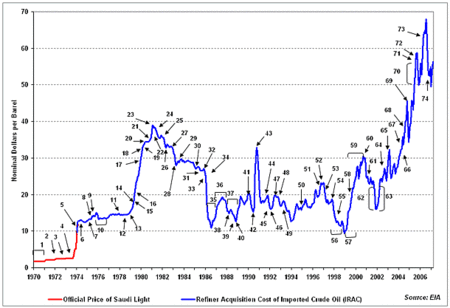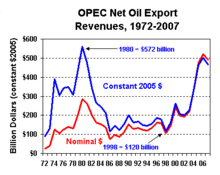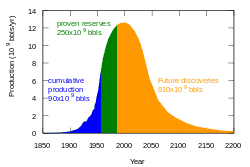1980s oil glut

The 1980s Oil Glut was a serious surplus of crude oil caused by falling demand following the 1970s Energy Crisis. The world price of oil, which had peaked in 1980 at over US$35 per barrel ($100 per barrel today), fell in 1986 from $27 to below $10 ($58 to $22 today).[2][3] The glut began in the early 1980s as a result of slowed economic activity in industrial countries (due to the crises of the 1970s, especially in 1973 and 1979) and the energy conservation spurred by high fuel prices.[4] The inflation adjusted real 2004 dollar value of oil fell from an average of $78.2 in 1981 to an average of $26.8 per barrel in 1986.[5]
In June 1981, The New York Times stated an "Oil Glut! ... is here" [6] and Time Magazine stated: the world temporarily floats in a glut of oil," [7] though the next week an article in The New York Times warned that the word "glut" was misleading, and that in reality, while temporary surpluses had brought down prices somewhat, prices were still well above pre-energy crisis levels.[8] This sentiment was echoed in November 1981, when the CEO of Exxon Corp also characterized the glut as a temporary surplus, and that the word "glut" was an example of "our American penchant for exaggerated language." He wrote that the main cause of the glut was declining consumption. In the United States, Europe and Japan, oil consumption had fallen 13% from 1979 to 1981, due to "in part, in reaction to the very large increases in oil prices by the Organization of Petroleum Exporting Countries and other oil exporters," continuing a trend begun during the 1973 price increases.[9]
After 1980, reduced demand and overproduction produced a glut on the world market, causing a six-year-long decline in oil prices culminating with a 46 percent price drop in 1986.

Production

Non-OPEC
During the 1980s, non-OPEC production increased worldwide.[10] By 1980 the Soviet Union was the world's largest producer of oil.[11]
US
In April 1979, Jimmy Carter signed an executive order which was to remove market controls from petroleum products by October 1981, so that prices would be wholly determined by the free market. Ronald Reagan signed an executive order on January 28, 1981 which enacted this reform immediately,<ref = Executive Order 12287>"Executive Order 12287 -- Decontrol of Crude Oil and Refined Petroleum Products". January 28, 1981. Retrieved 9 July 2008.</ref> allowing the free market to adjust oil prices in the US.<ref = Urban Transportation Planning>Edward Weiner (1999). Urban Transportation Planning in the United States An Historical Overview. Greenwood Publishing Group. p. 112. ISBN 978-0-275-96329-3. Retrieved 7 June 2010. By September 30, 1981, petroleum prices were to be determined by the free market. This process was accelerated by President Reagan through an Executive Order
</ref> This ended the withdrawal of old oil from the market and artificial scarcity, encouraging increased oil production. The US Oil Windfall profits tax was lowered in August 1981 and removed in 1988, ending disincentives to US oil producers. Additionally, the Alaskan Prudhoe Bay Oil Field entered peak production, supplying the US West Coast with up to 2 million bpd of crude oil.
OPEC
From 1980 to 1986, OPEC decreased oil production several times and nearly in half to maintain oil's high prices. However, it failed to hold on to its preeminent position, and by 1981, its production was surpassed by Non-OPEC countries. OPEC had seen its share of the world market drop to less than a third in 1985, from nearly half during the 1970s.[12] In February 1982, the Boston Globe reported that OPEC's production, which had previously peaked in 1977, was at its lowest level since 1969. Non-OPEC nations were at that time supplying most of the West's imports.[13]
OPEC's membership began to have divided opinions over what actions to take. In September 1985, Saudi Arabia became fed up with de facto propping up prices by lowering its own production in the face of high output from elsewhere in OPEC.[14] In 1985, daily output was around 3.5 million bpd down from around 10 million in 1981.[14] During this period, OPEC members were supposed to meet production quotas in order to maintain price stability, however, many countries inflated their reserves to achieve higher quotas, cheated, or outright refused to accord with the quotas.[14] In 1985, the Saudis were fed up with this behavior and decided to punish the undisciplined OPEC countries.[14] They abandoned their role as swing producer and began producing at full capacity, which created a "huge surplus that angered many of their colleagues in OPEC".[15] High-cost oil production facilities became less or even not profitable. Oil prices as a result fell to as low as $7 per barrel.[14]
US imports
The US imported 28 percent of its oil in 1982 and 1983, down from 46.5 percent in 1977, due to lower consumption. Reliance on Middle East sources dwindled even further as Britain, Mexico, Nigeria and Norway joined Canada in the forefront of American suppliers.[12]
Imported crude oil from Libya was banned in the United States on March 10, 1982.[16]
Reduced demand
OPEC had relied on the price elasticity of demand of oil to maintain high consumption, but underestimated the extent to which other sources of supply would become profitable as prices increased. Electricity generation from nuclear power and natural gas;[17] home heating from natural gas; and ethanol blended gasoline all reduced the demand for oil. New passenger car fuel economy rose from 17 mpg in 1978 to more than 22 mpg in 1982, an increase of more than 30 percent.[18]
Impact

The 1986 oil price collapse benefited oil-consuming countries such as the United States, Japan, Europe, and Third World nations, but represented a serious loss in revenue for oil-producing countries in northern Europe, the Soviet Union, and OPEC.
Canada responded to high energy prices in the 1970s with the National Energy Program (NEP) in 1980. This program was in place until 1985 and largely blamed for the collapse of the oil industry in the 1980s, leading to western alienation and the creation of the Reform Party of Canada and Western Separatist Movement.
In 1981, before the brunt of the glut, Time Magazine wrote that in general, "A glut of crude causes tighter development budgets" in some oil-exporting nations.[7] In a handful of heavily populated impoverished countries whose economies were largely dependent on oil production — including Mexico, Nigeria, Algeria, and Libya — government and business leaders failed to prepare for a market reversal.
With the drop in oil prices, OPEC lost its unity. Oil exporters such as Mexico, Nigeria, and Venezuela, whose economies had expanded in the 1970s, were plunged into near-bankruptcy. Even Saudi Arabian economic power was significantly weakened.
Iraq had fought a long and costly war against Iran, and had particularly weak revenues. It was upset by Kuwait contributing to the glut [20] and allegedly pumping oil from the Rumaila field below their common border.[21] Iraq invaded Kuwait territory in 1990, planning to increase reserves and revenues and cancel the debt, resulting in the first Gulf War.[21]
The USSR had become a major oil producer before the glut. The drop of oil prices contributed to the nation's final collapse.[22]
In the US, domestic exploration declined dramatically, and the number of active drilling rigs was nearly halved in 1982." Oil producers held back on the search for new oilfields for fear of losing on their investments.[23] In May 2007, companies like ExxonMobil were not making nearly the investment in finding new oil today that they did in 1981.[24]
See also
- 1973 oil crisis
- 1980-1989 world oil market chronology
- 1979 energy crisis
- Oil price increases since 2003
- Price of petroleum
References
- ↑ Annual Energy Review 2006, Energy Information Administration
- ↑ ROBERT D. HERSHEY JR. (1989-12-30). "Worrying Anew Over Oil Imports". The New York Times. Retrieved 26 April 2008.
- ↑ Mouawad, Jad (2008-03-08). "Oil Prices Pass Record Set in ’80s, but Then Recede". New York Time. Retrieved 2010-04-20.
- ↑ "Oil Glut, Price Cuts: How Long Will They Last?" 89 (7). U.S. News & World Report. 1980-08-18. p. 44.
- ↑ Oak Ridge National Lab data
- ↑ Robert D Hershey Jr. (1981-06-21). "How the Oil Glut is changing business". The New York Times. Retrieved 19 January 2008.
- ↑ 7.0 7.1 Christopher Byron (1981-06-22). "Problems for Oil Producers". Time Magazine. Retrieved 19 January 2008.
- ↑ DANIEL YERGIN (1981-06-28). "The Energy Outlook; LULLED TO SLEEP BY THE IL GLUT MIRAGE". Section 3; Page 2, Column 3. The New York Times.
- ↑ C. C. Garvin Jr. (November 9, 1981). "The Oil Glut in perspective". Annual API Issue; Pg. 151. Oil & Gas Journal.
- ↑ 10.0 10.1 EIA - International Energy Data and Analysis
- ↑ "World: Saudis Edge U.S. on Oil" in Washington Post Jan 3, 1980 pg. D2
- ↑ 12.0 12.1 Hershey Jr., Robert D. (1989-12-30). "Worrying Anew Over Oil Imports". The New York Times. Retrieved 2010-04-20.
- ↑ David Warsh (1982-02-28). "The economy: the Oil Glut deepens; OPEC's grip loosens; but a boom or a bomb could spur prices back up". Boston Globe.
- ↑ 14.0 14.1 14.2 14.3 14.4 Daniel Yergin, "The Prize: the Epic Quest for Oil, Money & Power.' Simon & Schuster 1991
- ↑ Stephen Koepp (1986-04-14). "Cheap Oil!". Time Magazine. Retrieved 19 January 2008.
- ↑ "Proclamation 4907 -- Imports of Petroleum". President of the United States. 1982-03-10. Archived from the original on 6 March 2008. Retrieved 2 February 2008.
- ↑ Ferenc L. Toth, Hans-Holger Rogner, (2006). "Oil and nuclear power: Past, present, and future" (PDF). Energy Economics 28 (1–25): pg. 3. Archived (PDF) from the original on 3 December 2007. Retrieved 4 January 2008.
- ↑ Paul R. Portney, Ian W.H. Parry, Howard K. Gruenspecht, and Winston Harrington (November 2003). "The Economics of Fuel Economy Standards" (PDF). Resources For The Future. Archived (PDF) from the original on 1 December 2007. Retrieved 4 January 2008.
- ↑ EIA Fact sheet
- ↑ Ted Thornton (2007-01-12). "The Gulf Wars: Iraq Occupies Kuwait". Northfield Mount Hermon School. Archived from the original on 17 December 2007. Retrieved 14 January 2008.
- ↑ 21.0 21.1 David L. Rousseau. "History of OPEC" (PDF). Archived (PDF) from the original on 27 February 2008. Retrieved 12 January 2008.
- ↑ Charles Ganske. "The Long War in the Middle East and Russian Oil". Archived from the original on 17 December 2007. Retrieved 12 January 2008.
- ↑ "Oil, Oil Everywhere". Forbes. 2006-07-24. Archived from the original on 8 January 2008. Retrieved 6 January 2008.
- ↑ Justin Fox (2007-05-31). "No More Gushers for ExxonMobil". Time magazine. Archived from the original on 13 January 2008. Retrieved 8 January 2008.
| ||||||||||||||||||||||||||||||||
Further reading
- World Hydrocarbon Markets: Current Status, Projected Prospects, and Future Trends, (1983), By Miguel S. Wionczek, ISBN 0-08-029962-8
- The Prize: The Epic Quest for Oil, Money, and Power, (1993), by Daniel Yergin, Simon & Schuster, ISBN 0-671-79932-0 & ISBN 0-671-50248-4
- The Oil Market in the 1980s: A Decade of Decline, (1992), by Siamack Shojai, Bernard S. Katz, Praeger/Greenwood, ISBN 0-275-93380-6
